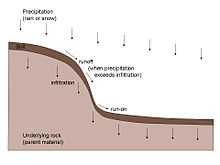Catena (soil)

A Catena in soil science (pedology) is a sequence of types of soil down a hill slope. Each soil type or "facet" differs somewhat from its neighbours, but all occur in the same climate and on the same underlying material. A mature catena is in equilibrium as the processes of deposition and erosion are in balance.
Open system

A catena (Latin: chain) is a chain of related soil types, known as facets, down a uniform slope.[1] The term was introduced by the soil scientist G. Milne in 1935, working in Africa, as the sequence of soils that ran from the crest of a hill to the floor of the swamp in the valley below it. In 1942, the American soil scientist T.M. Bushnell narrowed the definition to insist on a single parent material, so that drainage was the only difference (forming a Toposequence), but later authors such as Ruhe disagreed with this restriction.[2]

A catena forms when the climate, including precipitation and evaporation, is the same for the whole slope, and when sufficient time has passed for equilibrium to be reached between the processes that bring materials in to a facet and the processes that take materials away. The result is a predictable sequence of soil facets.[2] A catena is thus an open system which has continuous input and output processes. On a steeper slope in the middle of a catena, erosion, such as by runoff, is faster, so facets are typically thinner and drier. Conversely, on a shallower slope at the top or bottom of a catena, soils are thicker and deeper. In addition, the top facets lose materials such as mineral salts when these are washed out by rain (eluviation), while the bottom facets gain materials when these are washed in (illuviation).[1][2]
A catena can form on various underlying or parent materials and in different climates.[2] On impermeable acid rocks such as metamorphic schists in a high rainfall climate like that of Western Scotland, the catena consists of thick acidic peat forming wet bog on the flatter facets, and thinner, drier, somewhat less acidic peaty podsols on the steeper facets. Thus the soil depth, acidity (pH) and soil moisture vary continuously along the slope.[1][2] On a permeable basic rock such as chalk, the catena may consist of thick brown earths on the flatter facets, with thin rendzinas on the steeper slopes, while the valley bottom may include alkaline fen peat or river alluvium.
References
Bibliography
- Milne, G. (1936). "Normal erosion as a factor in soil profile development". Nature 138: 548–549.
- Milne, G. (1947). "A soil reconnaissance journey through part of Tanganyika Territory December 1935 to February 1936". Journal of Ecology 35: 192–265.
- Schaetzl, Randall J; Anderson, Sharon (2005). Soils: Genesis and Geomorphology. Cambridge University Press. pp. 469–474.
- Waugh, David (2000). Geography: An Integrated Approach. Nelson Thornes. p. 276.